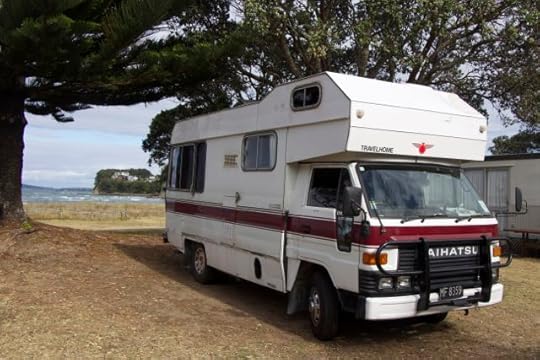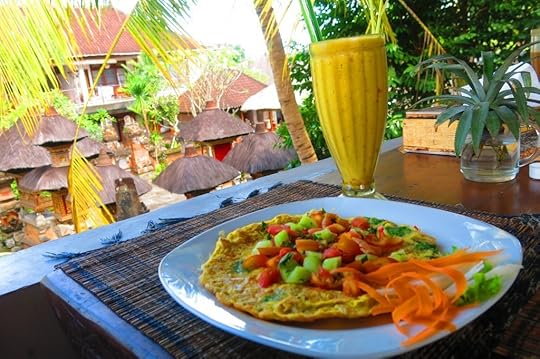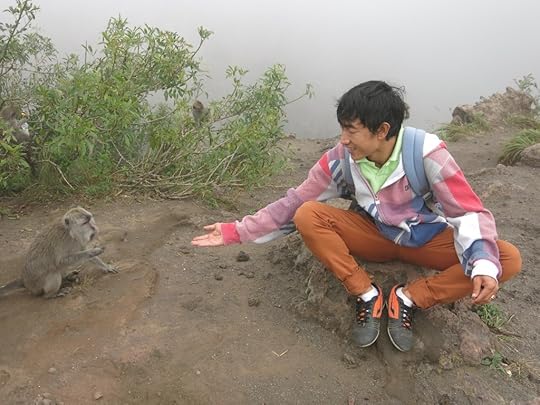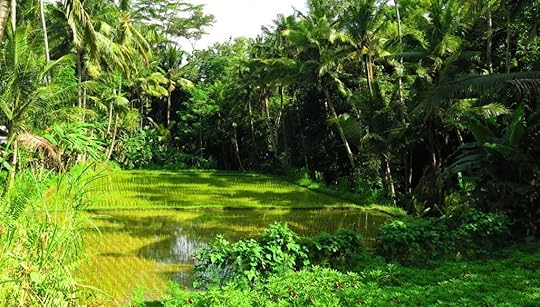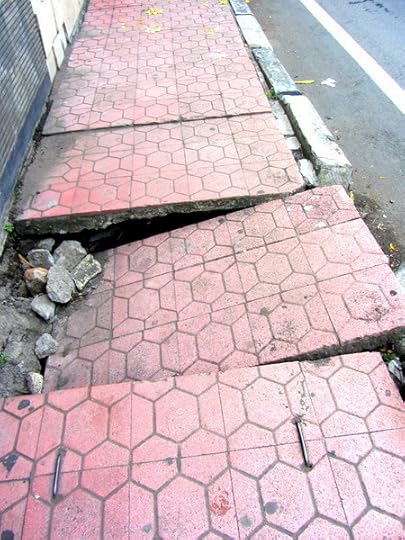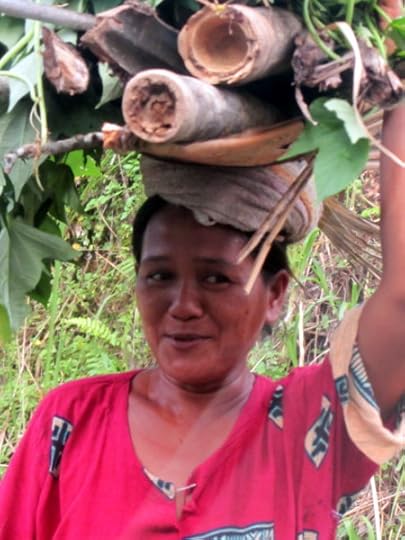Rolf Potts's Blog, page 56
August 27, 2013
Seeing New Zealand by camper van
Vagablogging :: Rolf Potts Vagabonding Blog
We just finished up a long, slow, six month wander New Zealand. I have to say, it’s been one of the pleasantest places we’ve had the privilege to travel. It definitely falls near the top of our “easy to travel” countries list.
Even if you’re a very new traveler, or have special needs, you’re going to find NZ a pleasure.
It’s first world
English speaking
Accessible in most places for wheelchairs
Sign-language is an official national language, so many people speak some
It is a virtually GMO free country, with excellent food labeling systems for people who have allergies or intolerances.
There are loads of playgrounds and skate parks in even the smallest towns
Children’s menus and pricing are ubiquitous
It’s compact and easy to get around, so in even a few weeks you can see a lot
Most museums are free, or by donation, which stretches the budget and the learning
It’s very safe, there’s nothing poisonous, you don’t need special vaccinations
It’s a very open, tourist-friendly culture
This is also a country made to be driven.
If you head to NZ and don’t hire a car and hit the roads, you’ll have missed some of the best the country has to offer. The cities (small by international standards) are wonderful, but it’s the countryside and the small towns that hold the real charm and the real adventure.
Lots and lots of people come to New Zealand every year to see the country by camper van or RV. My parents did, ten years ago, and their raving about their adventures here were a large part of why we decided to stay for so long. While the famous “free camping” that New Zealand has been known for, has been ratcheted down on somewhat in the last couple of years, due to abuse and misuse of public properties, there are still some free and very good low cost options. The catch: most tourists never find them.
Here’s why:
If you google “camper vanning New Zealand” or some such, what will come up is a long list of camper van and RV hire sites. Everything from the more than a little dodgy “Wicked” vans to the very efficiently marketed “Jucy” fleet, to the big “Kea” RVs (which is what we would have needed for our family of six with big kids.)
Knowing that the best way to see this country is by camping, it’s really tempting to hire a van. We know lots of people who have, with varying degrees of happiness with the service and results. It doesn’t seem like it will be *that much* more expensive than staying in a hotel, perhaps it will even be cheaper if you are used to staying in nice places and you’re only coming for a couple of weeks.
A few myths to be debunked:
Renting a camper van or RV in New Zealand is NOT CHEAP
Most of the best “free camping” sites and virtually all of the low cost ones you will not be able to use, but you’ll never even know it (I’ll tell you why in a moment).
Factor in the cost of gas (currently $2.25/L or $10/gallon) or diesel ($1.50/L or $6/gal) but with diesel there’ll be a tax surcharge which levels the playing field
With a rental you can expect to be paying for camping 80% or more of the time. If there are two of you, you might find campsites for as little as $20-30 a night, for our family of 6, we average $80 a night if we have to stay in a campground. Camping is charged by the head almost everywhere outside of North America.
While renting means that all taxes, registration and maintenance are rolled into your price, if you have trouble with your van, it is likely that you will have to return it to your point of origin to get it fixed, this is a real inconvenience if you’ve only got a few weeks. This happened to our friends. They opted to just fix it on their own dime so it wouldn’t ruin their trip. They were not reimbursed.
If you are from a righthand drive country there may be insurance differences.
Interested in how to get around much of that? There are options for the patient and the creative thinkers out there I wrote a very long explanation of how to make it happen without spending an arm and a leg and getting the “local” intel as the cherry on top!
Original article can be found here: Seeing New Zealand by camper van
August 25, 2013
The best travel involves abstract goals and concrete steps
Vagablogging :: Rolf Potts Vagabonding Blog
“First, goals for travel should be both generally related to abstract life goals — like becoming a better person, not accumulating stamps in a passport — but those abstract goals need to be broken into concrete steps to make them easier to accomplish. …Similarly, vacations are more effective if you use them to seek “desired states” rather than avoiding “undesired states.” In other words, hitting the Caribbean to get away from stress at work is less likely to improve your quality of life than going there to improve your scuba skills and your relationship with your partner. …Professor Sirgy’s theory also suggests that vacations are more effective if they provide things you are deprived of in your everyday life. Someone living in a bustling city like New York, for instance, might consider trading a trip to equally bustling London for a relaxing jaunt in the Cotswolds. And for the traveler who is stressed by budget issues at home, this might mean signing up for a (reasonably priced) all-inclusive resort to relieve those daily financial concerns. …And then there’s my favorite principle: that ‘goals chosen freely and autonomously are more intrinsically satisfying than goals set by others.’”
–Seth Kugel, “Travel Lessons From the World of Academia,” New York Times, 12/6/11, alluding to Joseph Sirgy’s “Toward a Quality-of-Life Theory of Leisure Travel Satisfaction”
Original article can be found here: The best travel involves abstract goals and concrete steps
August 22, 2013
Myanmar opens its eastern borders
Vagablogging :: Rolf Potts Vagabonding Blog
 Picture credits: Flickr/Travel Aficionado
Picture credits: Flickr/Travel Aficionado
It’s been in the air for a while, buzzing among the Southeast Asian traveler’s enclave, and making the day of many resolute overlanders. We all knew that the Golden land of Myanmar was changing. After the liberation of Aung San Suu Kyi, punk rockers storming the streets of Yangon, and everyone turning their backpacks to the country, something HAD to change, hadn’t it? And it has: now, the Thai-Myanmar borders are open to overland international traffic and travel, as reported by Mizzima.
People! Rejoice because the country that back in the 1980s wouldn’t let you in for more than 6 days, now has lifted travel restrictions on its eastern land borders. Regardless, the western side bordering with India and Bangladesh still remains locked, and pretty dangerous. Well, please be happy with this first accomplishment, and postpone your overland dreams of shaving off the bulk of Central Asia and China for the next decade, cool?
But my question is: how good will the opening of these land borders be for the country?
I am certainly not wishing that Myanmar stepped back into the darkness of its autocratic military regime, but at the same time, I am afraid that its face might change forever and ever. Something that was still quite magical will be lost, buried under a mound of foreign dollars.
In 2012, the country has already received 1 million tourists. 1 million! An awful lot for a place like Myanmar, which doesn’t have the infrastructures needed to support such an amount of arrivals. I’ve heard many horror stories of travelers who have been forced to sleep on guesthouses’ floors, and paying full price (a lapidary 20 $ minimum per person per night, quite a big sum for SE Asia today) as the demand for accommodation amply surpassed the supply. The Burmese are also starting to become a bit greedier, it seems. My experience goes back to year 2009, and I must say, I had a splendid time, and had basically the country all to myself. When I flew in – as it was impossible to enter by land back then-, my group of 4 whiteys was the only drops of clear skin inside of the airplane’s dark, bottled humanity. Now, the numbers have definitely changed: everyone I meet in Malaysia is bound -or he’s returning – from Myanmar. So much that it makes me feel like as of now, it’s Malaysia the place that nobody dares to visit!
The point of this post is to suggest to the new visitors to go to Myanmar with a respectful attitude, and an open mind. I would not like it if in five years I’ll meet people telling me how Myanmar be a new version of touristy Thailand. I’m crossing my fingers, but the responsibility is not on me. It’s on all those who decide to visit. Please, I am begging you, take care of Myanmar, until we can.
Original article can be found here: Myanmar opens its eastern borders
August 21, 2013
Vagabonding field report: The Czech Republic
Vagablogging :: Rolf Potts Vagabonding Blog

Cost/day: $40
What’s the strangest thing you’ve seen lately?
The Ossuary in Brno. This place is located on an unassuming street, between pubs and shops. You walk down a flight of stairs from the street and suddenly you are in an underground skeleton cave. The walls are stacked with real human bones. There is a feeling of creepiness, respect, and “no big deal” because it’s the Czech Republic and this kind of thing is normal.

Describe a typical day:
My boyfriend is Czech, so I have the privilege of having my own personal tour guide. We spent time in Prague, Pardubice, and Brno. In the morning we would eat Czech cake or bread with cheese and salami. We rode our bikes around town, stopping for snacks and beer. We saw castles, an animal sanctuary, lakes, historical war sites, and many pubs. Some days we would take a train to the next town to visit his friends or family. We spent a lot of time walking. It’s very hot in the summer so by the end of the day you are very ready for bed.

Describe an interesting conversation you had with a local:
“Dobry den! Czlzzch sleetsay zzzz ano dzz zzz lkjsadflkj pivo dobry!” Or something like that. Actually, I am trying to learn the language. Surprisingly, many people don’t (or won’t) speak English in the Czech, so my conversations with locals are limited to polite greetings and talking about colors and objects around me. Czechs speak in very quick tongue-twisters.
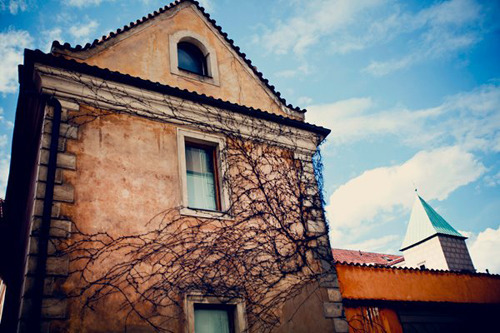
What do you like about where you are? Dislike?
I really love the Czech Republic. The people are interesting and the country is beautiful. Food and beer are cheap. There are lots of beautiful parks and nothing felt overly-touristy. The lack of air-conditioning can be a little uncomfortable in the summer months. But my main dislike is the Caraway seeds. I hate them and they are in almost every Czech food I come across.

Describe a challenge you faced:
Picking those stupid Caraway seeds out of everything. It can also be a little challenging getting around on your own because there are not many signs in English.

What new lesson did you learn?
As we all probably know, Czechs love their beer. One thing I learned though, is that you have to pour the beer in such a way that you are left with a cup full of foam. Then you wait for it to settle, and it tastes even better. If a Czech receives a beer with little or no foam, they have the “right” to throw it at the bartender. According to my boyfriend


Where next?
Next I’m looking at going to Alaska or Costa Rica. I’m in the US for the next few months so I would like to go somewhere that doesn’t involve a huge time change. More travels here!
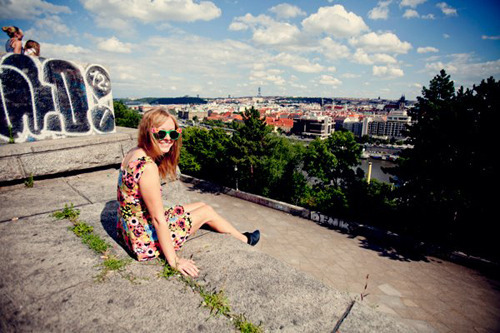
Original article can be found here: Vagabonding field report: The Czech Republic
August 20, 2013
Vagabonding field report: the endless visual candy of Ubud, Bali
Vagablogging :: Rolf Potts Vagabonding Blog
Cost/day: $50
What’s the strangest thing you’ve seen lately?
While touring a Balinese family’s compound, a thin old man came wandering through the home. He didn’t live there, and he didn’t speak or ask for money. He just stood there, vacant-eyed, with a bag on his back and no shoes on his feet. It was like seeing a ghost. The moment I put my camera in front of him was eerie and beautiful because I didn’t say anything, yet he didn’t move at all.
Describe a typical day:
I wake up to the roosters at sunrise. Life takes a more natural pace here—I don’t feel tired, even though it’s early. I hop on the back of someone’s motorbike and eat an awesome vegetarian breakfast in town. The best food I had was a tempeh lemongrass omelet with a chocolate mango chai latte. And coconuts. Lots of coconuts.
I wander around town a bit, but every day surprises me with something different. One day I biked twenty kilometers around rice paddies; the next day, I did nothing but eat and get a cheap, luxurious massage. I went to a barefoot Sunday morning dance at a yoga studio. I hiked a volcano. I watched a Balinese dance.
Ubud seems neverending in its greenery. It’s like nature and the intricate Hindu architecture have wrapped around each other in a luscious embrace. I can’t look at anything without finding moss, gold, petals, curlicues. I can barely stand to blink, it’s all so beautiful.
Describe an interesting conversation you had with a local:
I hired a guide to lead me up Mt. Batur, an active volcano, for a sunrise hike. The guide was twenty years old and working two jobs while going to school. Despite having to get up at 2:30 in the morning a few days a week, like many of the Balinese I met, he seemed genuinely happy with his life. He had an unshakeable affection for Bali and his culture.
What do you like about where you are? Dislike?
Though I didn’t make it to the beach, Ubud is still one of the most, if not THE most, beautiful place I’ve ever seen. The weather was a perfect 25 degrees Celsius and sunny most of the time. Exotic flowers, verdant jungle and tranquil gardens were ubiquitous.
I didn’t like haggling for everything. I know Southeast Asians enjoy it, but it made me uneasy. I felt I was either getting ripped off or cheating the business owner out of rightful pay. However, I did successfully bargain for a pair of sandals.
Describe a challenge you faced:
Getting around Ubud can be challenging. There are no taxis, and public van-buses are infrequent at best. I decided not to rent a motorbike because 1)I’ve never driven one, and 2) to my surprise, Indonesians drive on the left side of the road—the opposite way I’m used to.
Luckily, hitchhiking is completely normal. I only had to stick out a thumb once or twice. The locals offered me rides for a slightly inflated fee the rest of the time.
What new lesson did you learn?
I learned that finding a place to stay with like-minded people can make a solo trip ten times better. I stayed at a community art house, and every day there was someone new to meet, talk to and pair up with as travel buddies.
Where next?
I’m going to Cambodia to spend two weeks at a meditation retreat. This is the rest and recharge I need after teaching abroad in Korea for a year.
Original article can be found here: Vagabonding field report: the endless visual candy of Ubud, Bali
Samalona Island: Off the beaten track, Indonesia
Vagablogging :: Rolf Potts Vagabonding Blog
We loved Samalona Island…
It’s a tiny speck of an island off of the coast of the bigger island of Sulawesi, in central Indonesia. If you find yourself in Makassar, it’s well worth a few days of your time, or even a few hours if that’s all you’ve got, to retreat to this little isle and put the brakes on the wheels of life for a bit. If you’re searching the web for links to lodging or transportation to the island you won’t find much. The families on the island support themselves, in part, by hosting travelers, but no one has thought to create a website yet!
You will love Samalona if…
You are sick of big cities
You are a nature lover
You crave peace and quiet
You don’t need “entertainment”
You prefer a slow pace
You snorkel
Samalona might NOT be for you if
You’re not into swimming in the ocean or relaxing on a beach
You need air conditioning and “services”
You don’t eat fish
Even if you don’t want to stay overnight, you can visit Samalona Island for the day, enjoy the beach, take a snorkel and be back to “civilization” by evening.
Getting there:
Presumably you’ll be staying in a hotel in Makassar. Hop a little blue bus to “Fort Rotterdam” and then cross the street. I’ll be shocked if the boatmen don’t find you before your feet touch the sidewalk, but if they don’t, walk back onto the little “beach” behind the line of street food vendors and you’ll find several little wooden boats that make the trip back and forth.
If you’re going out for just the day, expect to pay about $30 USD for the round trip (the boatman will wait for you) It’s about an hour, one way.
If you’re going out for an overnight, or more, expect to pay about $40 USD for the round trip as the boatman will not wait… necessitating another round trip for him, which he may or may not be able to fill with new passengers on the day and time you wish to depart.
Accommodations
Lodging on Samalona Island is in the home of one of the families that lives there. There did appear to be two purpose built “rooms” for guests, but those were not open when we were there (and we were the only ones there.) The families all talked about the folks who had stayed in their homes over the years, and this seems to be the standard arrangement.
Because there are six of us, we were given an entire three bedroom house. We did not have access to the kitchen, but we didn’t need it as three ample meals plus coffee and fruit were provided. We were not hungry!
Some things to know about life on Samalona Island:
The beds are traditional Indonesian mats on top of boards, not cushy mattresses like you’re used to
There is a bed sheet on the bed, but no cover sheet or blankets provided
There are no screens on any windows (meaning insects can come in)
One of the three bedrooms we had included a mosquito net, the other two did not.
There is no electricity on the island. A generator runs after dark.
There is no running water on the island, it is carried from reservoirs and wells.
Toilets are bucket flush.
One house appeared to have a shower facility, gravity fed, we did not have one.
There is no hot water.
The food is homemade and excellent!
The company is delightful, take time to sit and talk with the residents (very little English spoken, bring your dictionary!
The snorkeling is okay. The reef is dying, as are so many, but there are still some good things to be seen.
There is a little store that rents snorkel gear (better to bring your own) and that has water, beer and a few snacks.
We heartily recommend Samalona Island
It was three of the best days we spent in Indonesia. The island is a respite from the insanity of the cities and we found it a “recharge” for our souls.
Original article can be found here: Samalona Island: Off the beaten track, Indonesia
August 18, 2013
Prejudice is not a European monopoly
Vagablogging :: Rolf Potts Vagabonding Blog
“Prejudice is not a European monopoly. My travel writing, for instance, in Pakistan and Afghanistan is really shaped by my childhood memory, common among small-town lower-middle-class Brahmins, of Muslims as threatening to “others” — and there are moments when I lapse into these inherited fears. I can’t write about China without discussing our nation’s image of the “devious” neighbor who stabbed our backs in 1962. And I can’t write about Israel without bringing in the great admiration my RSS-aligned family had for the Zionists who supposedly knew how to keep Muslims in their place.”
–Pankaj Mishra, Postcolonial Travel Writing: Critical Explorations (2010)
(2010)
Original article can be found here: Prejudice is not a European monopoly
August 13, 2013
Vagabonding with kids: You have to really WANT to do this
Vagablogging :: Rolf Potts Vagabonding Blog
“You really have to want to do this, don’t you, Dear?”
Ann’s words have echoed in my mind as her sweet, octogenarian face has pleasantly haunted my afternoon walks. We wandered slowly through the natural bridge outside of Waitomo, NZ, with her and her husband, Ross. I quietly got the kids’ attention and encouraged them to walk more slowly behind him, and not press forward as he did his aged best to step over tree roots and up the rocky stairs to the high meadow where we laughed together about the crazy idea of standing in the presence of 3 million year old oysters. Tony gave him a leg up over the fences. He laughed, good-naturedly, when the boys leapt out from behind blackberry bushes with a roar, as he had undoubtedly done forty years before I took my first breath.
Ann was hand washing for the two of them in a little tub out the back of her camper van, using water that Ross was bringing, one bucket at a time from the bridge. He’d lower the bucket the twenty or so feet to the surface with a long rope and then haul it up, mostly full, hand over hand before delivering it to his white haired wife. By the time she was done rinsing he was there to help her wring out his trousers, one on each end, twisting hard, and hang the clothes from a line he’s strung under the awning.
She commiserated with me over hand washing for six, producing meals for an army on two burners in a three foot square space, and the difficulties of adventuring with children. She’d raised a tribe too, in her day, and they’d camped the length and breadth of their island home. Perhaps she’s a premonition of myself.
You have to really want to do this.
I’ve been thinking about that statement, and the layers of meaning it embodies.
Truth be told, living this way is a lot of work. Staying home is far and away easier. But the best things in life are always the things that require the most from us, that we have to work our rear-ends off to achieve. The things we are proudest of mean so much to us because they’ve cost us the most.
Marriage is like that.
Raising kids is like that.
Traveling is like that.
All three together is the perfect storm of all that and two bags of chips.
There was so much encouragement in Ann’s face as we talked and washed and shared “mama” stories. The older I get the more I appreciate the stories of old women. I think because I’m just beginning to understand the many-layered thing that a woman’s life is, stretched thin over the better part of a century. Perhaps it’s because I can see myself in their eyes more clearly than I could at twenty, or thirty.
You have to really want to do this.
So many people give up. They give up on the thing they really, really want to do. There are so many reasons: It gets too hard. It costs too much. It hurts too badly. It isn’t what we signed up for. Someone else fails us. We fail ourselves. It’s inconvenient. It’s easier to stay home, in some capacity. We feel that we don’t deserve it, aren’t “worth” it. It’s a fight.
I’ve been thinking lots about the things I really want to do. The big things and the small things. The hard things and the harder things. The things that seem mundane, like staying married until I’m in my eighties, raising kids who are productive citizens and learning to write. The things that seem like pipe dreams too: seeing Antarctica, changing the world, and successfully handing my parents’ legacy to my grandkids. I really, really want to do these things.
For tonight, the things I really want to do included cooking 3 kilos of meat, enough potatoes, cheesy cauliflower & salad for an army, making a double batch of ginger cookies in a 16″ square camper oven and two gas burners, and making my husband laugh until he was squirming to get away from me, which is an accomplishment. I want to sit and sip my tea, munch my still warm ginger treat and thank the gods that be for friends who love me enough to mail me the exact type of tea that keeps me from killing the children who I want so desperately to strangle sometimes when we all are living in 126 square feet. And I’m willing to live in 126 square feet of rolling space because I really, really want, quite desperately, to make their childhood epic and not to miss a moment of it.
What do you really want to do?
Original article can be found here: Vagabonding with kids: You have to really WANT to do this
August 11, 2013
Writing can enable a sense of focus in one’s travels
Vagablogging :: Rolf Potts Vagabonding Blog
“The act of writing organizes how I spend my time when I arrive in a place. It gives me information, concentrates my thoughts, and opens doors I wouldn’t otherwise be allowed to knock on.”
–William Zinsser, “The Road to Timbuktu: Why I Travel,” American Scholar, Winter 1997
Original article can be found here: Writing can enable a sense of focus in one’s travels
August 6, 2013
Vagabonding Field Report: Making art out of life in Ubud, Bali
Vagablogging :: Rolf Potts Vagabonding Blog
Cost/day: Around $40/day
What’s the strangest thing you’ve seen lately?
I was walking around Ubud, which has so much traffic, and walking down the sidewalk there was a man with his cow!! There is a lot of traffic in Ubud, so it was very surreal to me. Plus, the sidewalks aren’t the easiest to navigate, so Iwas very impressed with the cow for doing so. I love all of the statues and how the Balinese make everything seem so reverent with their offerings and flowers and incense everyday. They have taught me how to show gratitude.
Describe a typical day:
I think a lot of tourists use Ubud as a base. They take lots of tours everyday, but then they miss the essence that is Bali. I just walked everyday. There was so much to see by just walking down the street. Beautiful people, flowers, the fragrance of pandan leaves, all of these things just made me so happy everyday. Also, I didn’t just walk in central Ubud. I walked out in the rice fields which were a world away from busy Ubud. My senses were just dancing everyday. There was so much to take in.
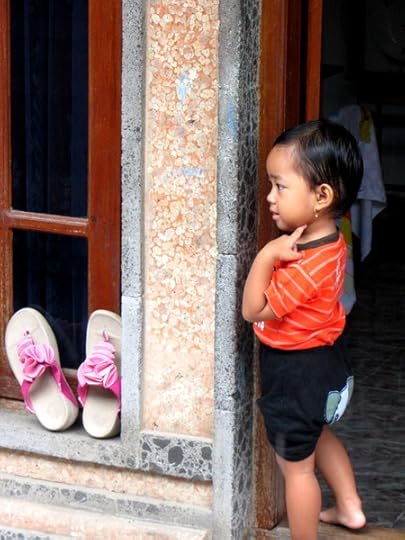
Describe an interesting conversation you had with a local:
I took painting classes from a local artist. I was amazed to learn that when he was a child he wanted to draw, but his family couldn’t afford pens or paper, so he drew in the dirt with a stick. It made me realize how much I take for granted.
What do you like about where you are? Dislike?
I loved how every day it felt like I was part of the art in Bali. I have never felt more in the moment than I did there. I love the friendly smiles of the people, the food, the serenity. I disliked the traffic. I wish they would do some better planning in that area.
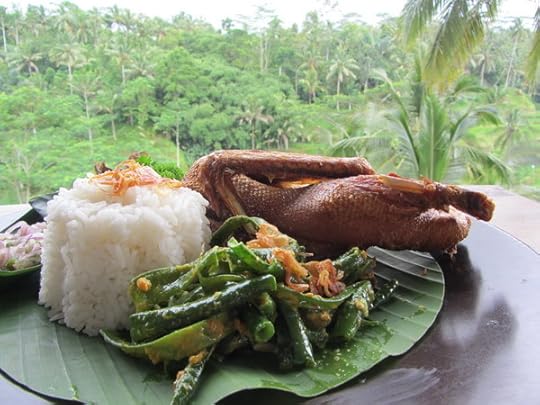
What new lesson did you learn?
I learned patience as many things took longer than I’m used to. Meals were two hour events. There were lots of lines at the grocery store or post office. I learned to just look at my surroundings and not be in a rush. I learned it was OK, to do nothing but sit back and watch the rice grow.
Where next?
I am headed to San Miguel de Allende in Mexico next. I am so excited and can’t wait to get there!
For more about my travels and great advice on beaches and islands, check out my website
This Way To Paradise and my Facebook page!
Original article can be found here: Vagabonding Field Report: Making art out of life in Ubud, Bali
Rolf Potts's Blog
- Rolf Potts's profile
- 323 followers


